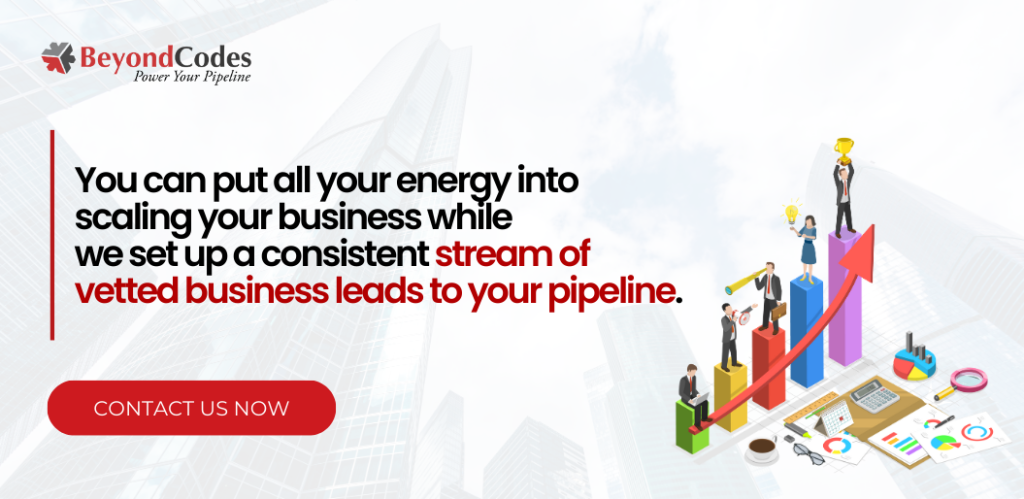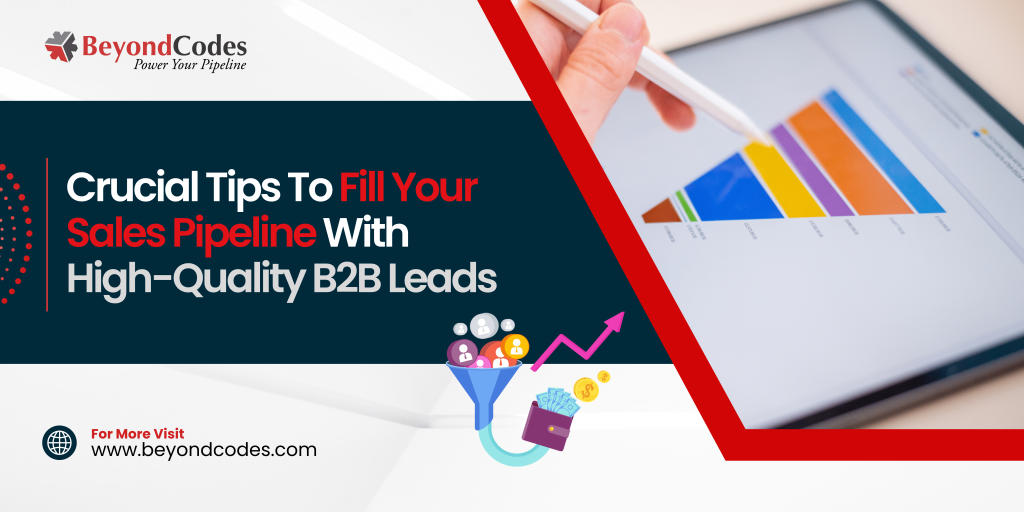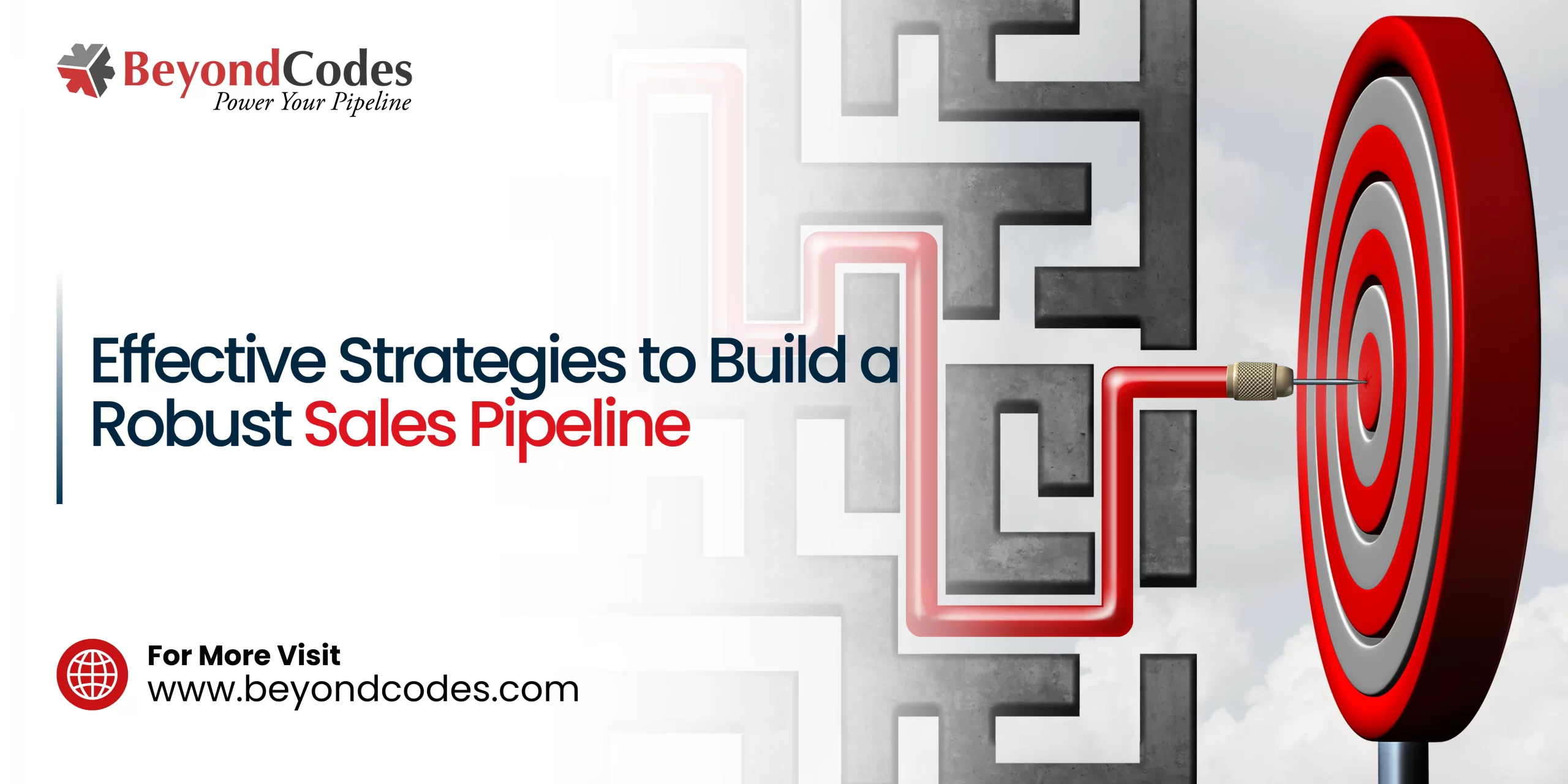Sometimes, sales teams find themselves without the vital support they require from marketing. This might be due to various factors, such as a lack of prioritization, budget constraints, or insufficient expertise.
Ideally, a collaborative effort with the marketing team can bridge these gaps. However, when such collaboration isn’t feasible, it falls upon the sales department to step up and take charge.
While the specifics can vary between organizations, industry benchmarks typically indicate that marketing contributes approximately 25-30% of qualified leads to the pipeline. When marketing isn’t delivering the expected quantity of leads, it becomes essential for sales to pick up the slack.
Here’s a comprehensive strategy for effectively managing the sales pipeline when you’re not receiving the desired support from marketing:
1. Prioritize Your B2B Lead Gen Outreach
It’s crucial to resist the temptation of diving into your contact list without a systematic approach. Wasting time on B2B leads that won’t convert is counterproductive.
To make your outreach efficient, the entire sales team should focus exclusively on prospects with the highest conversion potential. Surprisingly, there are often two excellent sources of high-quality B2B leads within your reach; they require a bit of effort to uncover.
Start by examining the accounts you’ve successfully closed in the past. Identify their industries, company sizes, and locations. This information forms the basis for creating your ideal buyer profile, and this process doesn’t have to be overly complex.
Establishing your ideal buyer profile is crucial because it guides your subsequent actions. Whenever you face decisions regarding content creation or email segmentation, return to your ideal buyer profile as your reference point.
With your ideal buyer profile defined, check if your marketing team can enhance the inbound leads they generate. It’s possible that their efforts are attracting promising leads, but you lack the necessary data to qualify them.
Data enrichment offers an additional advantage: it provides up-to-date contact details for these leads. So, not only will you have a list of qualified leads, but you’ll also possess accurate phone numbers and emails, ensuring your outreach reaches its intended recipients.
Additional data fields such as company size, industry, leadership changes, annual revenue, recent news, and technographic allow sales reps to establish rapport more swiftly by personalizing their messages.
Next, analyze your existing database to identify contacts and prospects who closely resemble your ideal buyers. If there are gaps in their information, enhance these leads by filling in crucial details.
You now have a list of high-quality B2B leads and prospects and contacts from your existing database who are most likely to convert.
2. Leverage B2B Intent Data to Identify Ready Buyers
There’s one more step to pinpointing the B2B prospects with the highest conversion potential, and it involves identifying a group of potential buyers you might not even be aware of yet.
To achieve this, you need intent data to uncover high-quality B2B leads actively seeking a solution like yours. Intent data falls into two categories: first-party and third-party.
Third-party intent data, especially from reputable aggregators, provides the most comprehensive view of potential buyers in the market for your product or service.
It’s essential to remember that only a small fraction (2-5%) of your target audience is actively engaged in the buying process at any given moment.
Intent data enables you to identify this select group, allowing you to focus your efforts on leads actively seeking a solution like yours.
This approach avoids wasting time on prospects who may seem promising but aren’t actually in the market for your solution.
Combining high-quality contact data with intent data will compile a list of accounts and contacts that align with your ideal buyer profile and are actively seeking a solution.
These leads are more likely to engage, schedule demos or meetings, and ultimately convert. When you reach out to them, the data will provide valuable insights into their skills and interests, giving you a competitive edge even before your initial conversation.
Read More: Embracing the Power of Intelligent Technology: How B2B Marketers Feel About AI
Acquiring New Leads That Match Your Ideal Customer Profile (ICP)
After acquiring the right tools, optimizing your processes, and pinpointing your ideal buyers, it’s time to supercharge your efforts and increase your output.
The objective here is to maximize your existing resources’ results or expand your prospecting efforts to involve a broader team.
This expansion will significantly extend the number of accounts you can cover, engage ideal buyers in a personalized manner, and ultimately drive an increase in leads and pipeline deals.
Collaborate with a trusted B2B data platform that can offer comprehensive market coverage, perform data verification at scale, and precisely filter potential buyers to ensure that every outreach attempt is productive and fruitful.
Adopting a multi-channel approach is essential since you’re stepping in to fill marketing gaps.
This encompasses various channels, from email marketing to outbound calls and social media.
With highly accurate data at your disposal, you’ll spend more time engaging with your ideal buyers, nurturing relationships, and scaling your outreach instead of struggling to track down their contact details, including phone numbers and social profiles.

Addressing the Demand for Content
Regardless of your chosen tactics, one thing remains constant – the need for content.
Before you embark on creating your content, take a moment to evaluate your options.
It’s possible that the marketing team has resources available to support content development for outreach campaigns and sequences, and this content might already exist.
Surprisingly, almost 70% of valuable content created by marketing goes unused by sales simply because it’s challenging for sales teams to locate.
Consider the following
- Can marketing assist you in finding the right content, collateral, or offers?
- Can they help in planning outreach messaging?
- Are there in-house writers and designers accessible to you? If not, can they recommend external resources?
If internal support for content creation is unavailable, think about collaborating with a content consultant who can strategize and create the necessary content for engaging with prospects.
Ideally, this consultant should develop a content package that you can repurpose and recycle. Consistently generating content can be more demanding and time-consuming than data research.
Focus on leveraging impactful pieces like guides and white papers, then spin them into shorter formats such as articles or infographics.
Use your ideal buyer profile to determine how you’ll segment the content. Personalize content based on specific titles or industries and make adjustments within the content to tailor it to each segment.
If you can segment your audiences to receive different messages, the ability to filter contact data will be vital for delivering personalized messages. Achieving a more effective and high-quality contact list that converts is best accomplished by targeting specific skill sets.
For instance, if you’re targeting marketers specializing in marketing automation and email marketing, you may want to filter for contact profiles with skills in Pardot, Eloqua, or Marketo.
Personalizing content is often the most challenging hurdle for ABM teams, but filtered data can overcome this challenge. It’s important to note that not all B2B data providers offer the capability to segment contact lists by skills; most focus only on titles and functions.
Measuring Your Progress
With everything set up, it’s crucial to monitor your effectiveness. Here’s a reliable approach for assessing your reps, their activity levels, and overall conversions.
To manage the sales pipeline effectively, measure your reps’ activity and conversion rates daily, weekly, and quarterly. This tracking allows you to identify which reps are effectively employing best practices like personalization.
Don’t forget to share these insights across the department once you’ve confirmed their effectiveness.
Also, track your cadences. Segment them by persona and assess which cadences, cadence steps, and messaging strategies yield the most conversions for each audience.
This analysis helps you concentrate your efforts on prospects with the highest likelihood of conversion and the messages that resonate most with them.
While the marketing gap in your organization may be temporary, utilize the strategies outlined in this article to maintain a healthy pipeline and meet your performance targets.
Furthermore, consistently scheduling meetings, converting leads, and generating revenue can boost team morale, countering disappointment from a lack of marketing support.
Establishing B2B Lead Generation Sales Pipeline Stages
Creating clear sales pipeline stages is essential for effective sales management and tracking high-quality B2B leads progress. Here are commonly adopted sales pipeline stages:
1. B2B Demand Generation/Prospecting: This initial stage involves generating leads from various sources, including marketing campaigns, referrals, or networking. It entails identifying and capturing potential customers who have expressed interest in the product or service.
2. B2B Lead Qualification: In this stage, leads are assessed and qualified based on predefined criteria to determine their suitability and potential as customers. Qualification factors may include budget, needs, decision-making authority, and readiness to purchase.
3. Needs Analysis: After qualifying leads, the sales team delves deeper into understanding the prospect’s specific needs, pain points, and challenges. Comprehensive discussions and data gathering help tailor the approach to align with the customer’s requirements.
4. Solution Presentation: At this point, the sales team presents the product or service to the qualified prospect, highlighting its features, benefits, and value proposition to address the customer’s needs and solve their problems.
5. Proposal and Negotiation: Following the presentation, a formal proposal is provided to the prospect, outlining the proposed solution, pricing, terms, and any customization options. Negotiations may occur to address concerns, objections, or specific requirements to reach a mutually agreeable deal.
6. Closing: The closing stage involves obtaining the customer’s commitment to proceed with the purchase. Contracts are finalized, purchase orders are issued, and any necessary paperwork or legal requirements are completed.
7. Post-Sale/Retention: The focus shifts to post-sale activities once the deal is closed. This stage includes high-quality B2B leads onboarding, ensuring a seamless transition, providing ongoing support, and nurturing the relationship to enhance customer satisfaction, encourage repeat business, and potentially gain referrals.

Parting Thoughts
It’s important to recognize that these stages are not always linear and may overlap or vary in duration depending on the complexity of the sales process and the high-quality B2B leads buying journey.
Adapting these pipeline stages to align with your organization’s specific B2B sales process and customer dynamics is essential for effective pipeline management.
We can deliver best-in-class solutions by utilizing a mix of proven and new techniques, leveling up each team member’s skill set, and using cutting-edge tools.
The List of Articles that You Can Read:
- 7 Proven Social Media Engagement Strategies for B2B Lead Generation
- Understanding the Prospects Firmographics, Demographics and Pychographics in B2B Lead Generation
- Beyond Codes Is Making Their Presence Felt In The LA B2B Lead Generation Industry
- 15 Steps to Secure B2B Lead Generation Quality Leads
- Maximizing B2B Lead Generation in the era of Accountability Measurability and Automation







